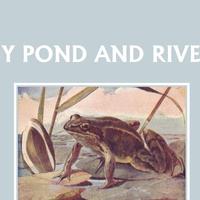CHAPTER 1. A FROG'S LIFE
CROAK, croak, croak, we hear the frogs in the month of March. They make a great deal of noise in this month, because they are just awaking from their winter's sleep, at the bottom of the pond. The mother frogs are laying their tiny dark eggs in the water. Each egg is not bigger than a grain of sand. But it has a coat of jelly, and this jelly swells and swells in the water, till it is as large as a pea, with a little black dot in the middle. The jelly lumps all cling together. You may see them in almost any pond, driven up to the side by the wind.
Soon the dark speck lengthens. A head grows at one end, and a tail at the other. The head has a mouth but no eyes as yet. The tail has a fin all round it, and the tadpole wriggles about in its slimy bed.
In about a week it wriggles out of the jelly, and hangs by its mouth to the weeds. Then two curious tufts grow on each side of its head. It uses these tufts to breathe, by taking air out of the water. You can see them if you dip a glass into the pond and catch a few tadpoles.
By this time the tadpole has let go of the weed and is swimming about. A sharp beak has grown on to his mouth. He uses it to tear off pieces of weed to eat. Now he grows eyes, nose-holes and flat ears. His tufts shrivel up, and a cover grows over them, so that you cannot see them. They are now like the gills of a fish. He gulps water in at his mouth and sends it out through the cover. As it passes, the gills take the air out of it, and so the tadpole breathes.
Soon two small lumps appear on each side of his body, behind the cover, just where it joins his tail. They grow larger and larger, till at last two hind legs come out. These legs grow very long and strong, and he uses them to swim. Two front legs are growing as well, but you cannot see them, because they are under the cover. In a few days these peep out, but they are short and stumpy.
Our tadpole has now four legs and a tail. He has four toes on the front feet, and five toes on the hind feet, with a skin between the toes. So his hind legs are web-footed, and this helps him to swim.
He comes to the top pf the water much more often than before, and sends a bubble of air out of his mouth. What do you think has happened? The gills under his cover have closed up, and a small air-bag has grown inside him. So he comes up to breathe in the air through his mouth, instead of taking it out of the water through his gills.
Now he likes to jump on a piece of weed and sit in the shade. He does not want his tail any longer, for he can swim quite well with his legs. So his tail is slowly sucked in to feed his body.
There you have your little frog. If you look through the web of his foot at the sun, you will see that he has red blood now. But it is not warm blood like ours. He is always cold and clammy because his blood moves slowly.
He has a number of teeth in the top of his mouth, and such a curious tongue. It is tied down to the front of his mouth, and the tip, which is very sticky, lies back down his throat. He does not eat weed now. He feeds on insects and slugs. He catches them by throwing out his tongue and drawing it back very quickly.
He lives chiefly on land during the summer if he is not eaten by ducks, rats, or snakes. Then he drops to the bottom of the pond to sleep in the mud all winter.

